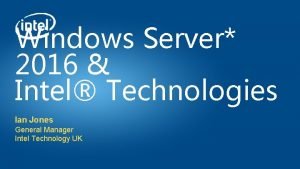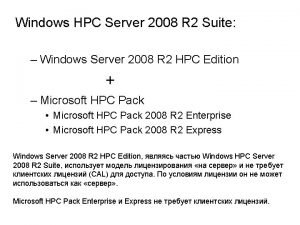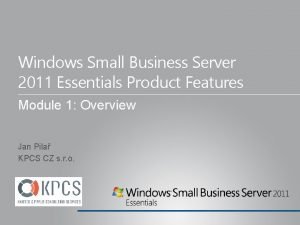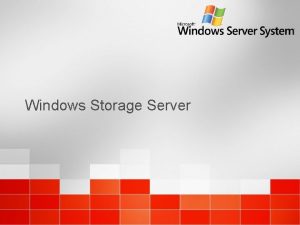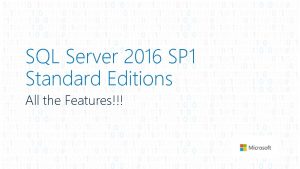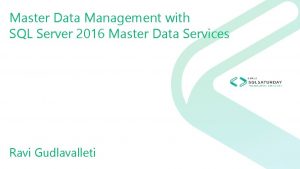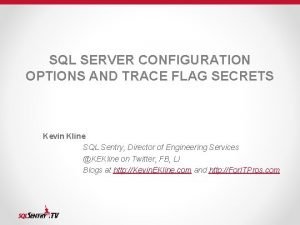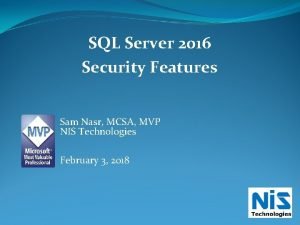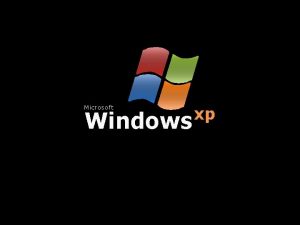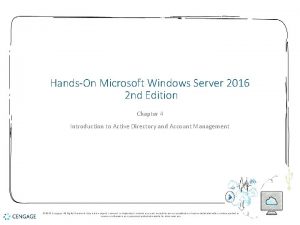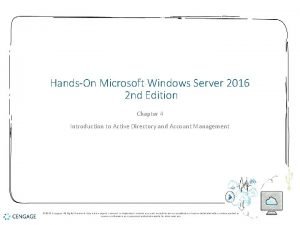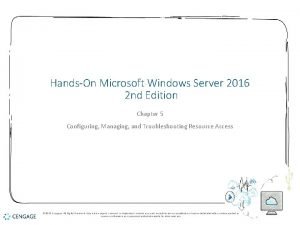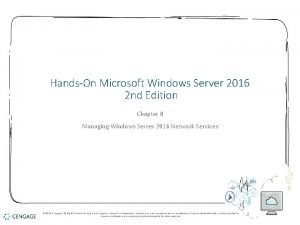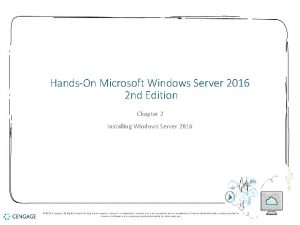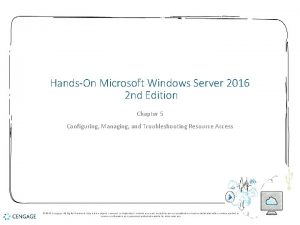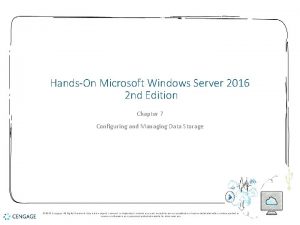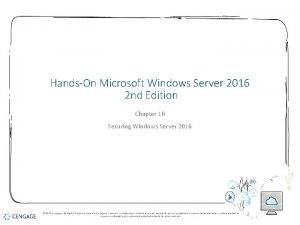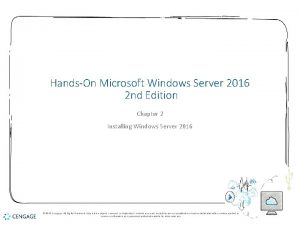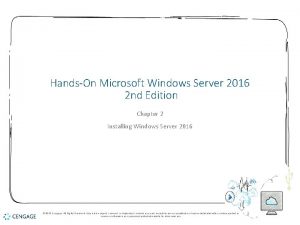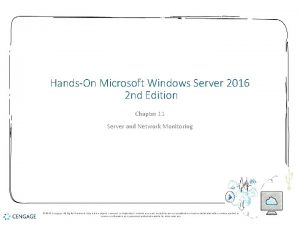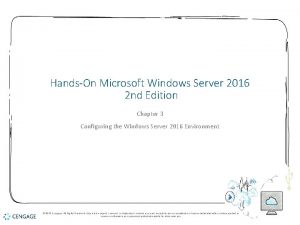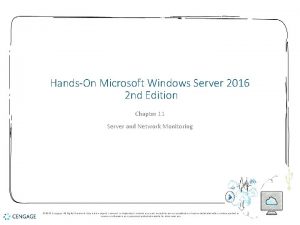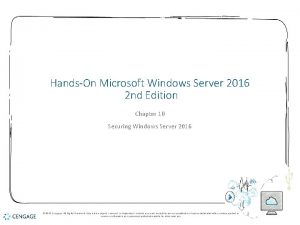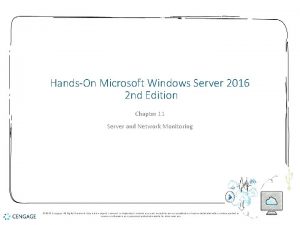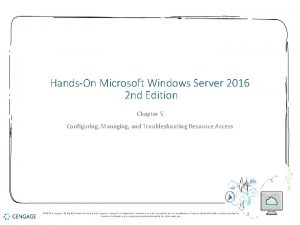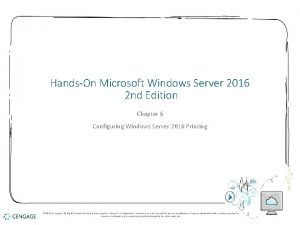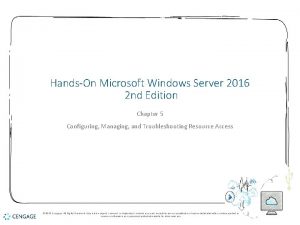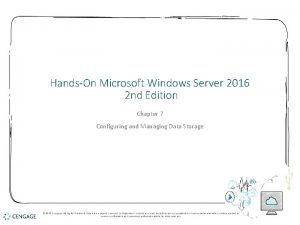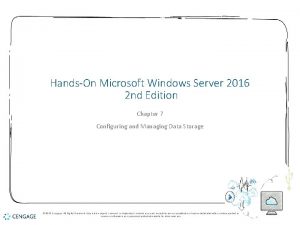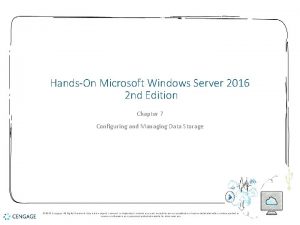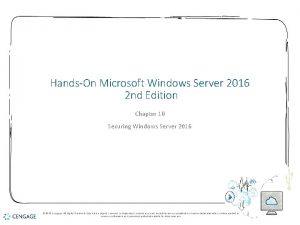HandsOn Microsoft Windows Server 2016 2 nd Edition





























- Slides: 29

Hands-On Microsoft Windows Server 2016 2 nd Edition Chapter 8 Managing Windows Server 2016 Network Services © 2018 Cengage. All Rights Reserved. May not be copied, scanned, or duplicated, in whole or in part, except for use as permitted in a license distributed with a certain product or service or otherwise on a password-protected website for classroom use.

Objectives Install, configure, and troubleshoot DNS Create a DNS implementation plan Install, configure, and troubleshoot DHCP Install the IP Address Management tool Configure NIC teaming Install, configure, and troubleshoot Microsoft Internet Information Services © 2018 Cengage. May not be copied, scanned, or duplicated, in whole or in part, except for use as permitted in a license distributed with a certain product or service or otherwise on a passwordprotected website for classroom use.

Implementing Microsoft DNS • Domain Name System (DNS) • A TCP/IP application protocol that enables a DNS server to resolve (translate): - Domain and computer names to IP addresses - IP addresses to domain and computer names • DNS servers provide the DNS namespace for an enterprise • One of the requirements for using Active Directory on a Windows Server 2016 network is to have a DNS server on the network • Windows Server 2016 DNS is the most compatible with Active Directory • Non-Microsoft servers can be used but they must be compatible with Active Directory © 2018 Cengage. All Rights Reserved. May not be copied, scanned, or duplicated, in whole or in part, except for use as permitted in a license distributed with a certain product or service or otherwise on a password-protected website for classroom use. 3

Installing DNS Services (1 of 2) • DNS is installed as a server role in Windows Server 2016 • After you install DNS • You’ll need to configure elements in DNS such as zones (described in next sections) • For optimal results, develop a DNS implementation plan before you set up DNS in a production environment • Activity 8 -1 will step you through installing DNS © 2018 Cengage. All Rights Reserved. May not be copied, scanned, or duplicated, in whole or in part, except for use as permitted in a license distributed with a certain product or service or otherwise on a password-protected website for classroom use. 4

Installing DNS Services (2 of 2) © 2018 Cengage. All Rights Reserved. May not be copied, scanned, or duplicated, in whole or in part, except for use as permitted in a license distributed with a certain product or service or otherwise on a password-protected website for classroom use. 5

DNS Zones (1 of 3) • DNS name resolution is enabled through the use of tables of information • That link computer names and IP addresses • The tables are associated with partitions in a DNS server that are called zones • Contain resource records • Each zone houses tables of different types of resource records • Called zone file or zone database • Forward lookup zone • The zone that links computer names to IP addresses • Holds host name records called address records © 2018 Cengage. All Rights Reserved. May not be copied, scanned, or duplicated, in whole or in part, except for use as permitted in a license distributed with a certain product or service or otherwise on a password-protected website for classroom use. 6

DNS Zones (2 of 3) • In IP version 4, a host record is called a host address (A) resource record • An IPv 6 record is called an IPv 6 host address (AAAA) resource record • When you install DNS on a domain controller (DC) in a domain • A forward lookup zone is automatically created for the domain with the DNS server’s address record already entered • You must enter the records of other hosts or configure DHCP to automatically update the DNS forward lookup zone each time it leases an IP address • A DNS server can have several forward lookup zones • There should be at least one for the parent domain © 2018 Cengage. All Rights Reserved. May not be copied, scanned, or duplicated, in whole or in part, except for use as permitted in a license distributed with a certain product or service or otherwise on a password-protected website for classroom use. 7

DNS Zones (3 of 3) • Reverse lookup zone • Holds the pointer (PTR) resource record, which contains the IP address-to-host name • Not used as commonly as the forward lookup zone • Because reverse lookup zones are used less often • It is not automatically configured when DNS is installed • Activity 8 -2 shows you how to create a reverse lookup zone • Activity 8 -3 steps you through creating a Host Address A Resource Record © 2018 Cengage. All Rights Reserved. May not be copied, scanned, or duplicated, in whole or in part, except for use as permitted in a license distributed with a certain product or service or otherwise on a password-protected website for classroom use. 8

Using the DNS Dynamic Update Protocol (1 of 2) • Microsoft DNS is also called Dynamic DNS (DDNS) • A modern form of DNS that enables client computers and DHCP servers to automatically register IP addresses • DNS dynamic update protocol • Enables information in a DNS server to be automatically updated in coordination with DHCP • After configuring DNS • Always make sure that it is configured to sue the DNS dynamic update protocol • Saves administrators time because they no longer have to manually register each new workstation or each time a new IP lease is issued • Activity 8 -4 shows you how to verify the DNS dynamic update configuration © 2018 Cengage. All Rights Reserved. May not be copied, scanned, or duplicated, in whole or in part, except for use as permitted in a license distributed with a certain product or service or otherwise on a password-protected website for classroom use. 9

Using the DNS Dynamic Update Protocol (2 of 2) © 2018 Cengage. All Rights Reserved. May not be copied, scanned, or duplicated, in whole or in part, except for use as permitted in a license distributed with a certain product or service or otherwise on a password-protected website for classroom use. 10

DNS Replication (1 of 2) • Primary DNS server • The DNS server that is the main administrative server for a zone and thus is also the authoritative server for that zone • Secondary DNS server • Backup DNS server for a primary DNS server • Contains a read-only copy of the primary DNS server’s zone database, but is not used for administration (is not authoritative) • Obtains that copy through a zone transfer over the network © 2018 Cengage. All Rights Reserved. May not be copied, scanned, or duplicated, in whole or in part, except for use as permitted in a license distributed with a certain product or service or otherwise on a password-protected website for classroom use. 11

DNS Replication (2 of 2) • Vital services performed by secondary DNS servers: • To make sure that there is a copy of the primary DNS server’s data • To enable DNS load balancing among a primary DNS server and its secondary servers • To reduce congestion in one part of the network • If you use Active Directory and have two or more DCs • Plan to set up Microsoft DNS services on at least two of the DCs • The multimaster replication model enables you to replicate DNS information on each DC • Advantage of replicating DNS information • If one DC that hosts DNS services fails, another DC is available to provide uninterrupted DNS services © 2018 Cengage. All Rights Reserved. May not be copied, scanned, or duplicated, in whole or in part, except for use as permitted in a license distributed with a certain product or service or otherwise on a password-protected website for classroom use. 12

Stub Zone • Stub zone has only the bare necessities for DNS functions, which are copies of the following: • SOA record zone • Name server (NS) records to identify authoritative servers • A record for name servers that are authoritative • One common use for a stub zone is to help quickly resolve computer names between two different namespaces • By enabling clients in one namespace to instantly find an authoritative server in a different namespace • The steps for creating a stub zone are similar to those used to create a primary or secondary zone © 2018 Cengage. All Rights Reserved. May not be copied, scanned, or duplicated, in whole or in part, except for use as permitted in a license distributed with a certain product or service or otherwise on a password-protected website for classroom use. 13

Additional DNS Server Roles (1 of 4) • It is common to designate one DNS server to forward name resolution requests to a specific remote DNS server • DNS forwarding can be set up that if the DNS server that receives the forwarded request cannot resolve the name • The server that originally forwarded the request attempts to resolve it • Called nonexclusive forwarding • Windows Server 2016 supports the use of root hints • A resource record to enable a DNS server to quickly find an authoritative DNS server in a zone that is not on the DNS server • Used in particular to find an authoritative DNS server on the Internet © 2018 Cengage. All Rights Reserved. May not be copied, scanned, or duplicated, in whole or in part, except for use as permitted in a license distributed with a certain product or service or otherwise on a password-protected website for classroom use. 14

Additional DNS Server Roles (2 of 4) © 2018 Cengage. All Rights Reserved. May not be copied, scanned, or duplicated, in whole or in part, except for use as permitted in a license distributed with a certain product or service or otherwise on a password-protected website for classroom use. 15

Additional DNS Server Roles (3 of 4) © 2018 Cengage. All Rights Reserved. May not be copied, scanned, or duplicated, in whole or in part, except for use as permitted in a license distributed with a certain product or service or otherwise on a password-protected website for classroom use. 16

Additional DNS Server Roles (4 of 4) • A DNS server can function as a caching server • A caching server is used to provide fast queries because the results of each query are stored in RAM • A DNS server without zones is a server that is caching-only • A caching-only DNS server queries a primary or secondary DNS server and caches the results to provide a fast response for the next identical query • Used to reduce the number of secondary server and reduce extra network traffic • One limitation of using caching servers is that it takes time for each one to build up a comprehensive set of resolved names to IP addresses • Sometimes it is necessary to flush the DNS server cache • Steps for clearing the cache on are page 341 of the text © 2018 Cengage. All Rights Reserved. May not be copied, scanned, or duplicated, in whole or in part, except for use as permitted in a license distributed with a certain product or service or otherwise on a password-protected website for classroom use. 17

Using DNS to Balance Application Access • In DNS round robin • Resource records are created for two or more servers that have different IP addresses but are associated with the same host name • An effective way to help spread the load for frequently used applications that have their own data sets • Through DNS round robin • Access is evenly distributed among all servers associated with the same host name • No single server is loaded down with all users while other servers sit idle • The general steps to configure DNS round robin and netmask ordering are found on pages 342 -344 © 2018 Cengage. All Rights Reserved. May not be copied, scanned, or duplicated, in whole or in part, except for use as permitted in a license distributed with a certain product or service or otherwise on a password-protected website for classroom use. 18

Troubleshooting DNS • Steps to take to troubleshoot DNS problems: • Restart the DNS Server and the DNS Client services • Check for the most recent log errors relating to DNS • Activity 8 -5 shows you how to restart the DNS Server and Client services • Activity 8 -6 shows you how to check for DNS errors in the log information kept by Windows Server 2016 © 2018 Cengage. All Rights Reserved. May not be copied, scanned, or duplicated, in whole or in part, except for use as permitted in a license distributed with a certain product or service or otherwise on a password-protected website for classroom use. 19

Implementing Microsoft DHCP (1 of 2) • Dynamic Host Configuration Protocol (DHCP) • Enables a Windows Server 2016 server with DHCP services to detect the presence of a new workstation • Assigns an IP address to that workstation • The DHCP server has a pre-assigned range of IP addresses that it can give to a new client • Range of contiguous addresses is called the scope • A Windows Server 2016 server can be configured in the role of a DHCP server using Microsoft DHCP services • The DHCP server automatically updates the DNS server at the time it assigns an IP address • Using dynamic DNS updates can significantly save time in creating DNS lookup zone records © 2018 Cengage. All Rights Reserved. May not be copied, scanned, or duplicated, in whole or in part, except for use as permitted in a license distributed with a certain product or service or otherwise on a password-protected website for classroom use. 20

Implementing Microsoft DHCP (2 of 2) • A Microsoft DHCP server can also: • • Reserve an IP address for a specific computer Update all computers on a network for a particular change in DHCP settings Provide DHCP services to multiple subnetworks Exclude certain IP addresses from a scope • You can configure DHCP failover for redundancy • Consists of configuring two DHCP servers to lease IP addresses using the same subnet or scope • DHCP data is replicated between the two servers so that if one goes down, clients can still use the remaining live DHCP server • When you configure two DHCP servers for failover • You can also configure to use load-balancing © 2018 Cengage. All Rights Reserved. May not be copied, scanned, or duplicated, in whole or in part, except for use as permitted in a license distributed with a certain product or service or otherwise on a password-protected website for classroom use. 21

Configuring a DHCP Server (1 of 2) • After DHCP is installed, set up one or more scopes of contiguous address ranges and activate each scope • Configuring a scope includes the following: • Obtain the range of addresses to be used • Determine the subnet mask for the range of addresses • Decide on a name for the scope, such as naming it to reflect the name of a department or division in your organization • Decide how long to lease IP addresses • Determine whether to exclude specific addresses © 2018 Cengage. All Rights Reserved. May not be copied, scanned, or duplicated, in whole or in part, except for use as permitted in a license distributed with a certain product or service or otherwise on a password-protected website for classroom use. 22

Configuring a DHCP Server (2 of 2) • Next, authorize the DHCP server • The process of authorizing the server is a security precaution to make sure IP addresses are only assigned by DHCP servers that are managed by network and server administrators • A step that is not required, but that saves time in managing DNS, is to configure the DHCP server and its clients to automatically update DNS records • Activity 8 -8 shows you how to configure a DHCP scope • Activity 8 -9 shows how to verify that a DHCP server is configured to automatically register IP addresses with a DNS server © 2018 Cengage. All Rights Reserved. May not be copied, scanned, or duplicated, in whole or in part, except for use as permitted in a license distributed with a certain product or service or otherwise on a password-protected website for classroom use. 23

Lease Times • Set the duration of a DHCP lease on the basis of the type of connection • Microsoft recommends the following: • If you have a small network with no routers, a lease of 8 days or less is appropriate • On a network with one or more routers, a larger number of clients, and client computer that generally stay put, set leases to expire after a longer period (16 -24 days) • On a network that has a large percentage of mobile devices, set leases to expire after the duration of the communication session (8 -24 hours) - Consider 1 -8 hours for high turnover of mobile users, such as a library, doctor’s office, or coffee shop © 2018 Cengage. All Rights Reserved. May not be copied, scanned, or duplicated, in whole or in part, except for use as permitted in a license distributed with a certain product or service or otherwise on a password-protected website for classroom use. 24

Redundancy Through NIC Teaming (1 of 3) • NIC teaming • Congregated NICs operate as one logical connection • Benefits of NIC teaming • Distributes the load (for NIC load balancing) among the teamed NICs to provide users faster access to the server • Users still have access to the server even when one NIC fails • NIC teaming combines bandwidth for faster access • Three NIC teaming configurations: • Static teaming • Switch-independent teaming • Link Aggregation Control Protocol (LACP) © 2018 Cengage. All Rights Reserved. May not be copied, scanned, or duplicated, in whole or in part, except for use as permitted in a license distributed with a certain product or service or otherwise on a password-protected website for classroom use. 25

Redundancy Through NIC Teaming (2 of 3) • When you configure NIC teaming, you have three load-balancing methods from which to choose: • Hyper-V Port • Address hash • Dynamic • The general steps for configuring a NIC team are found on page 359 © 2018 Cengage. All Rights Reserved. May not be copied, scanned, or duplicated, in whole or in part, except for use as permitted in a license distributed with a certain product or service or otherwise on a password-protected website for classroom use. 26

Redundancy Through NIC Teaming (3 of 3) © 2018 Cengage. All Rights Reserved. May not be copied, scanned, or duplicated, in whole or in part, except for use as permitted in a license distributed with a certain product or service or otherwise on a password-protected website for classroom use. 27

Chapter Summary (1 of 2) • DNS is used to resolve domain and computer names to IP addresses and vice versa • Before you install DNS, ensure that the server to house this role has a static address • After you install DNS as a server role, the next step is to configure forward and reverse lookup zones, as well as DNS resource records • When you configure Dynamic DNS, you enable automated IP address registration in a coordinated way with a DHCP server • Plan to set up two or more DNS servers on most networks • DHCP dynamically leases IP addresses to client computers • Configuring DHCP involves configuring scopes that are IP address ranges from which addresses are leased to clients © 2018 Cengage. All Rights Reserved. May not be copied, scanned, or duplicated, in whole or in part, except for use as permitted in a license distributed with a certain product or service or otherwise on a password-protected website for classroom use. 28

Chapter Summary (2 of 2) • Windows Server 2016 DHCP server supports both IPv 4 and IPv 6 • IPAM is a set of tools you can use for IP address management • NIC teaming enables you to aggregate multiple NICs in a server to appear as one logical connection © 2018 Cengage. All Rights Reserved. May not be copied, scanned, or duplicated, in whole or in part, except for use as permitted in a license distributed with a certain product or service or otherwise on a password-protected website for classroom use. 29
 Networking with windows server 2016
Networking with windows server 2016 Nouveauté windows server 2016
Nouveauté windows server 2016 Windows hpc server
Windows hpc server Cluster dhcp
Cluster dhcp Microsoft official academic course microsoft word 2016
Microsoft official academic course microsoft word 2016 Microsoft official academic course microsoft excel 2016
Microsoft official academic course microsoft excel 2016 Microsoft official academic course microsoft word 2016
Microsoft official academic course microsoft word 2016 Sql server compact edition
Sql server compact edition Small business server 2010
Small business server 2010 Windows small business server 2011 end of life
Windows small business server 2011 end of life Microsoft windows storage server 2003
Microsoft windows storage server 2003 Microsoft windows movie maker windows 7
Microsoft windows movie maker windows 7 James handson
James handson Handson may
Handson may A handson
A handson James handson
James handson James handson
James handson A handson
A handson Handson activities
Handson activities Handson activities
Handson activities Handson session
Handson session Sql server 2016 sp
Sql server 2016 sp Sql server master data management
Sql server master data management Sql server 2016 management studio
Sql server 2016 management studio Sql server trace flag 1118
Sql server trace flag 1118 Dts sql server 2005
Dts sql server 2005 Sql server 2016 security features
Sql server 2016 security features Testout server pro
Testout server pro Using mis 10th edition
Using mis 10th edition Mis
Mis
